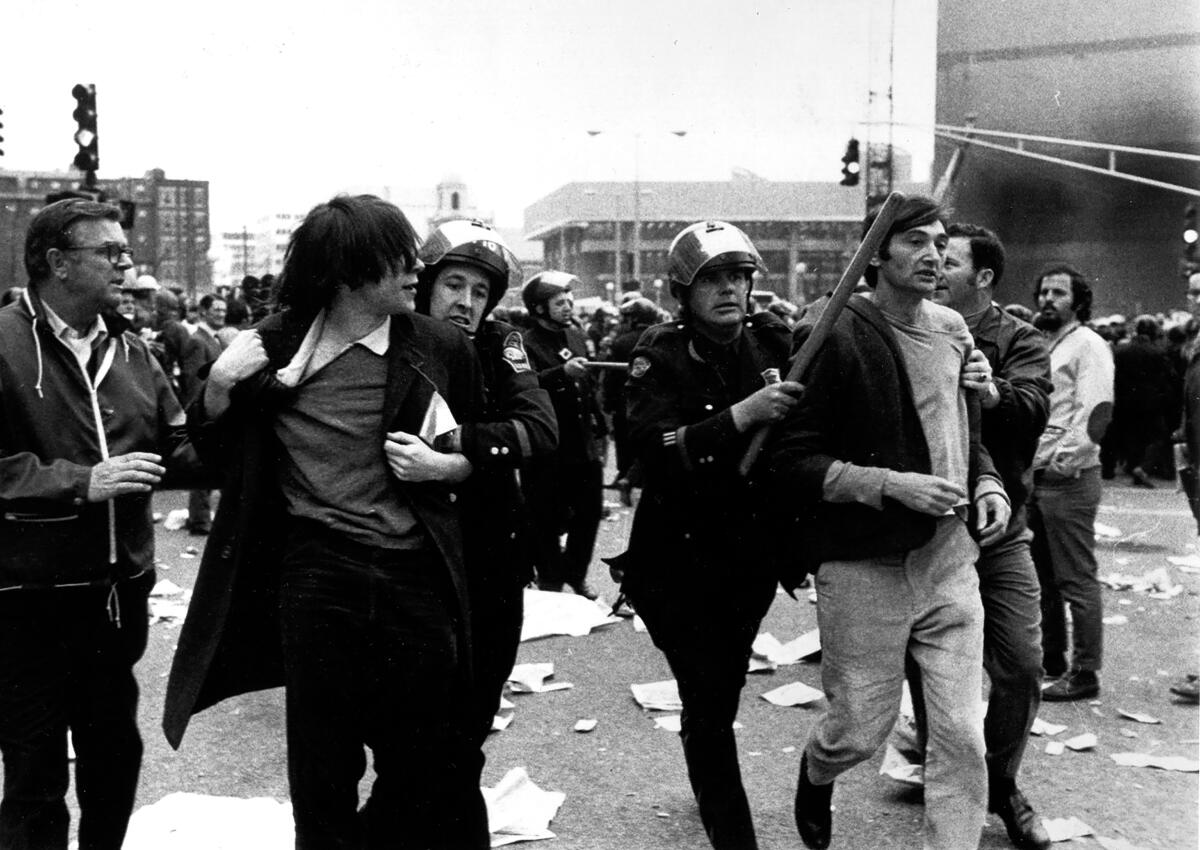‘You Can’t Be Neutral on a Moving Train’ and more election day viewing ideas

Welcome to Screen Gab, the newsletter for everyone looking for something to inspire them — or soothe them — as election day arrives.
This week, Screen Gab editor Matt Brennan recommends the always timely wisdom of historian Howard Zinn, whose perspective shapes the documentaries “You Can’t Be Neutral on a Moving Train” and “A People’s History of the United States.”
Also in issue No. 155, we suggest rewatching “The West Wing” and setting a reminder for “The Daily Show” election special. Plus, we talk baseball with the director of Netflix’s new docuseries “The Comeback.”
Screen Gab Live: 'Before'
What: Free screening of Apple TV+’s ‘Before,’ followed by a Q&A with star Billy Crystal and showrunner Sarah Thorp. Free 3-hour parking with validation; free popcorn and refreshments provided
When: Monday, Nov. 4 | 7 p.m.
Where: The Culver Theater, 9500 Culver Blvd., Culver City, CA 90232
How: Be sure to RSVP today!
ICYMI
Must-read stories you might have missed

‘What We Do in the Shadows’ is approaching the end, but ‘life goes on’ in the vampire comedy: Showrunner Paul Simms and cast members discuss their otherworldly comedy, now in its sixth and final season.
Everything you need to know about Death before the ‘Agatha All Along’ finale: Aubrey Plaza’s Rio Vidal was revealed to have been Death all along. Here’s everything you need to know about the character before the “Agatha All Along” finale.
PETA files new motion in Tonia Haddix case, citing ‘Chimp Crazy’ as evidence: PETA filed a new motion Wednesday asking the court to compel Haddix and her alleged accomplices to show why they should not be held in contempt of court, detailing evidence that aired in the HBO docuseries.
Martha Stewart is an ‘unreliable narrator’ but also ‘a visionary,’ documentary director says: R.J. Cutler, the director of Netflix’s ‘Martha,’ discussed his film about the lifestyle guru and businesswoman and how he isn’t bothered by her criticism of it.
Turn on
Recommendations from the film and TV experts at The Times

‘The Daily Show Presents a Live Election Night Special’ (Comedy Central, simulcast)
If you’ve been doomscrolling and viewing clips and political news nonstop like me (and if you’re not, congratulations on keeping your sanity), you’re probably wondering what you should watch on election night to keep track of the races. I tend to flip through the networks, but I always make a stop at “The Daily Show.” This year’s election-night episode, titled “Indecision 2024: Nothing We Can Do About It Now,” marks 24 years of the “Daily Show” special, which originated during Jon Stewart’s first run on Comedy Central’s satirical news program. And it feels like deja vu not just because Stewart is back as host, but because there is a high probability that we’ll have a repeat of 2000, where we won’t know the winner of the presidential race until after election day. (Remember those hanging chads?) At minimum, the show serves as an hour to deride the maps, magic walls and needles that will inevitably rule the night. And Stewart, who plans to stick around through 2025 in his once a week hosting gig, can continue to help us make sense of it all once we know who prevails. —Maira Garcia
READ MORE: Election news is heavy on video clips. Go deeper with these 10 documentaries, series and specials

‘The West Wing’ (Max)
Folks are doing, and advising, all sorts of things to remain calm during this uniquely stressful presidential election. I’m sure yoga and burning sage offer some relief but I have chosen to rewatch “The West Wing.” Currently celebrating its 25th anniversary, Aaron Sorkin’s workplace drama offers the soothing combination of nostalgia — gather round while I tell of a time when broadcast networks could win Emmys for best drama — and political aspiration. Was there ever a White House run by a mere half dozen quick-witted, friendship-bound aides with no ambition beyond serving their quantifiably brilliant economist president and the people? Of course not. Does it remain deeply pleasurable to watch an extraordinary group of writers, directors and actors attempt to convince us otherwise? Yes indeed. Also a tiny bit sad. “The West Wing” was followed by the darker (but undeniably entertaining) visions of “24,” “Scandal” and “Veep” and the more general rise of the antihero. “West Wing” was often pointed and certainly partisan — it was in many ways a centrist Democrat’s fever dream — but it was never politically mean-spirited. Which makes it even more of a revelation, 25 years later, than it was when it premiered. —Mary McNamara
Catch up
Everything you need to know about the film or TV series everyone’s talking about

In the documentaries “You Can’t Be Neutral on a Moving Train” (2004) and “A People’s History of the United States” (2015), both streaming on Kanopy, scholar Howard Zinn lays claim to the original meaning of radicalism: Going to the root of the problem.
Born in Brooklyn to working-class immigrant parents and raised in a series of cold water flats, Zinn — by turns shipyard organizer, Air Force veteran, civil rights activist, antiwar protester, university professor, public intellectual — did not so much escape poverty and injustice as spend a lifetime confronting their causes, ultimately fashioning a survey of the American experience written from the perspective of its “rabbits,” rather than its “hunters.” First published in 1980, “A People’s History” placed sit-ins and wildcat strikes at the center of our national narrative, and interpreted such direct action — even when unsuccessful — as evidence of opposition to capitalism, militarism and white supremacy that had too often been written out of the story. “I start from the supposition that the world is topsy-turvy, that things are all wrong,” Zinn, who died in 2010, once described the perspective that led him to write history from below: “That the wrong people are in power, and the wrong people are out of power.” As a result, his work awakened readers to the role played by class conflict, racial injustice, gender inequality and imperial might in a country whose history has traditionally been framed as a victory march.
Of course, at a brisk 78 and 90 minutes, respectively, “You Can’t Be Neutral” and “A People’s History” barely scratch the surface of the Jamestown settlement or the Ludlow Massacre. (Ken Burns, take note: The survey text practically cries out for the “Civil War” treatment.) The films focus instead on Zinn’s conceptual innovations, particularly his understanding that the government, the law, the police and other major institutions in American life are officially or unofficially owned by, and act in the service of, wealthy, powerful interests — who in turn treat the decisions of those institutions as “holy writ.” Moral outrage and grassroots resistance to those interests, Zinn posited, were the only means of genuine social change; to be silent in the face of the establishment was indeed to endorse it. “I don’t believe it’s possible to be neutral,” he said. “The world is already moving in certain directions, and to be neutral, to be passive, in a situation like that is to collaborate with whatever’s going on.” — Matt Brennan
Guest spot
A weekly chat with actors, writers, directors and more about what they’re working on — and what they’re watching

When the Dodgers had the Yankees down 3-0 in the World Series earlier this week, the trailing team’s desperate fans and loyal supporters of their archrival Boston Red Sox could agree on at least one thing: “The Comeback” was the only historical precedent the men in pinstripes had for hope. Netflix, now streaming a new docuseries of the same name, could scarcely have planned it any better. Colin Barnicle’s three-part deep dive into Red Sox’s epic victory over the Yanks in the 2004 American League Championship Series, a prelude to their first World Series title in 86 years, is catnip to those, like me, who watched our team “reverse the curse” in real time — and a reminder, for everyone else, that baseball is a game of miracles. Barnicle stopped by Screen Gab recently to discuss his memories of ‘04, what he’s watching and more. —Matt Brennan
What have you watched recently that you’re recommending to everyone you know?
I just saw Jason Reitman’s film “Saturday Night,” which was great. I’m not a “Saturday Night Live” aficionado or anything but it had all the things I really enjoy — amazing characters with high stakes — and it really let you into that experience of trying to accomplish something you’re overzealous about and yet doubtful of the outcome. On the documentary side, “Super/Man: The Christopher Reeve Story” (VOD) and “The Greatest Night in Pop” [Netflix] are two spectacularly executed pieces where you follow the characters through the story, rather than it being the other way around.
What’s your go-to “comfort watch,” the film or TV show you return to again and again?
If “Raiders of the Lost Ark” [Prime Video, Paramount+] or “Butch Cassidy and the Sundance Kid” [VOD] are on, I’m watching. But at night, after my wife and I put the children to bed, we’re putting on “Seinfeld” [Netflix]. The whole idea of no good deed goes unpunished, trying to force an outcome, it never gets old and it’s never not funny.
What’s your most potent personal memory of the Sox’s championship run in 2004?
It’s the first time I’d ever taken a picture with my cellphone. A year prior, my father took my younger brother, Tim, and I to Yankee Stadium for Game 7 and the Red Sox lost. It was devastating. Tim was bawling his eyes out — I don’t know, maybe I was too — and my father leaned down and hugged my brother and said, “I can’t believe I did this to you.” He’d given him something that didn’t love him back: the Red Sox. A year later, we were there again. Same seats, same Game 7, and the Red Sox won and in the chaos of the moment, Tim and I snuck onto the field and Tim ran the bases. He was 11, could barely make it around, winded as all hell as he rounded third base to home and he shouted, “I can’t believe it” and I pulled out my cellphone and took a picture. It’s on the wall at my parents’ house right when you walk in the door.
Between “The Comeback” and “This Is a Robbery,” your two highest profile series to date have taken on Boston-centric subjects. What’s a Boston story you’d still like to tell, if you could do anything?
Boston is a city of neighborhoods. Each one has their own story. The old adage used to be that you either had a priest, a cop, a criminal or all three in your family and this in a place with the best higher education, best hospitals and an outsized punch in politics. There’s no shortage of good stories in Beantown. You can never limit it to just one. That’s the best part.
The complete guide to home viewing
Get Screen Gab for everything about the TV shows and streaming movies everyone’s talking about.
You may occasionally receive promotional content from the Los Angeles Times.






